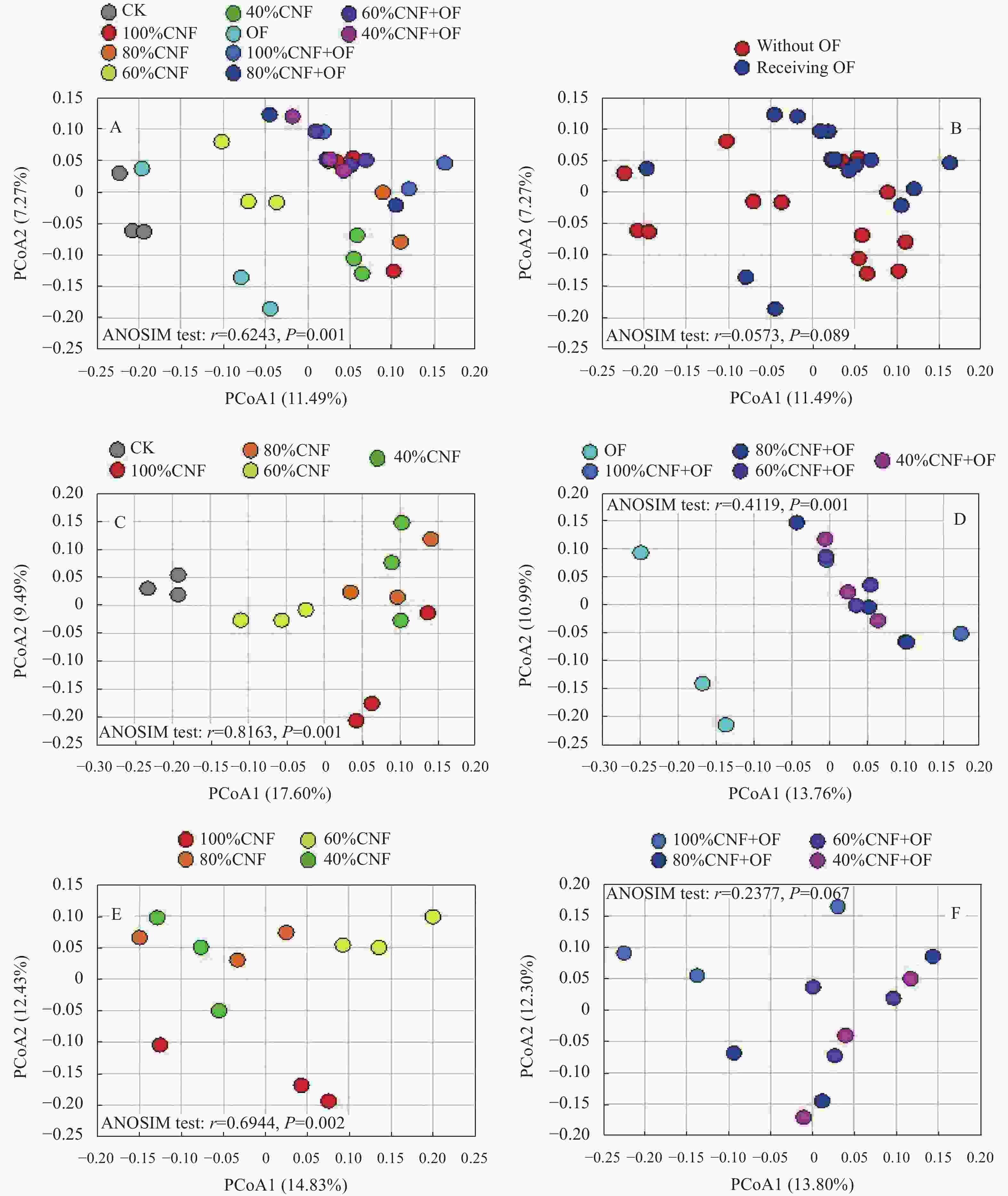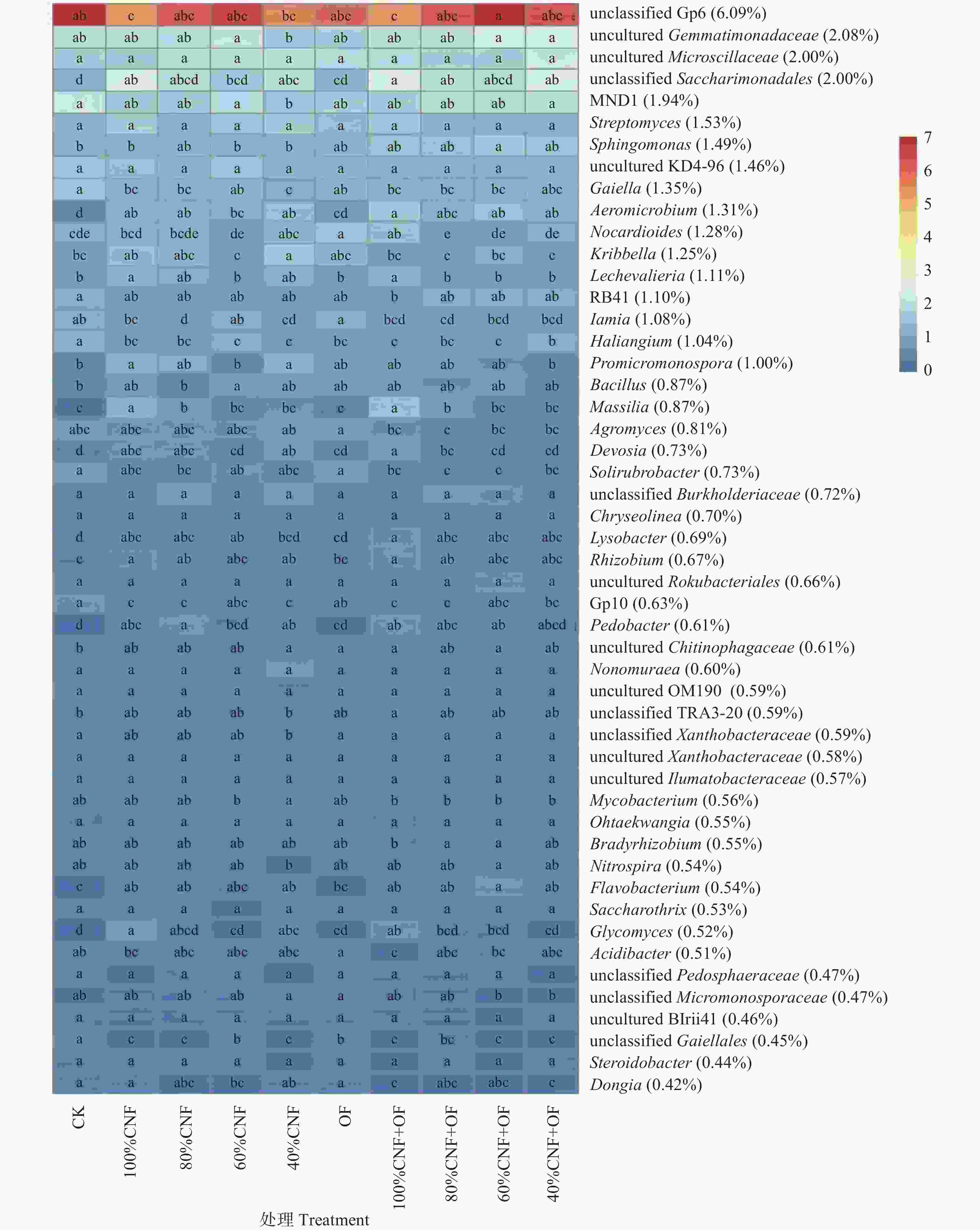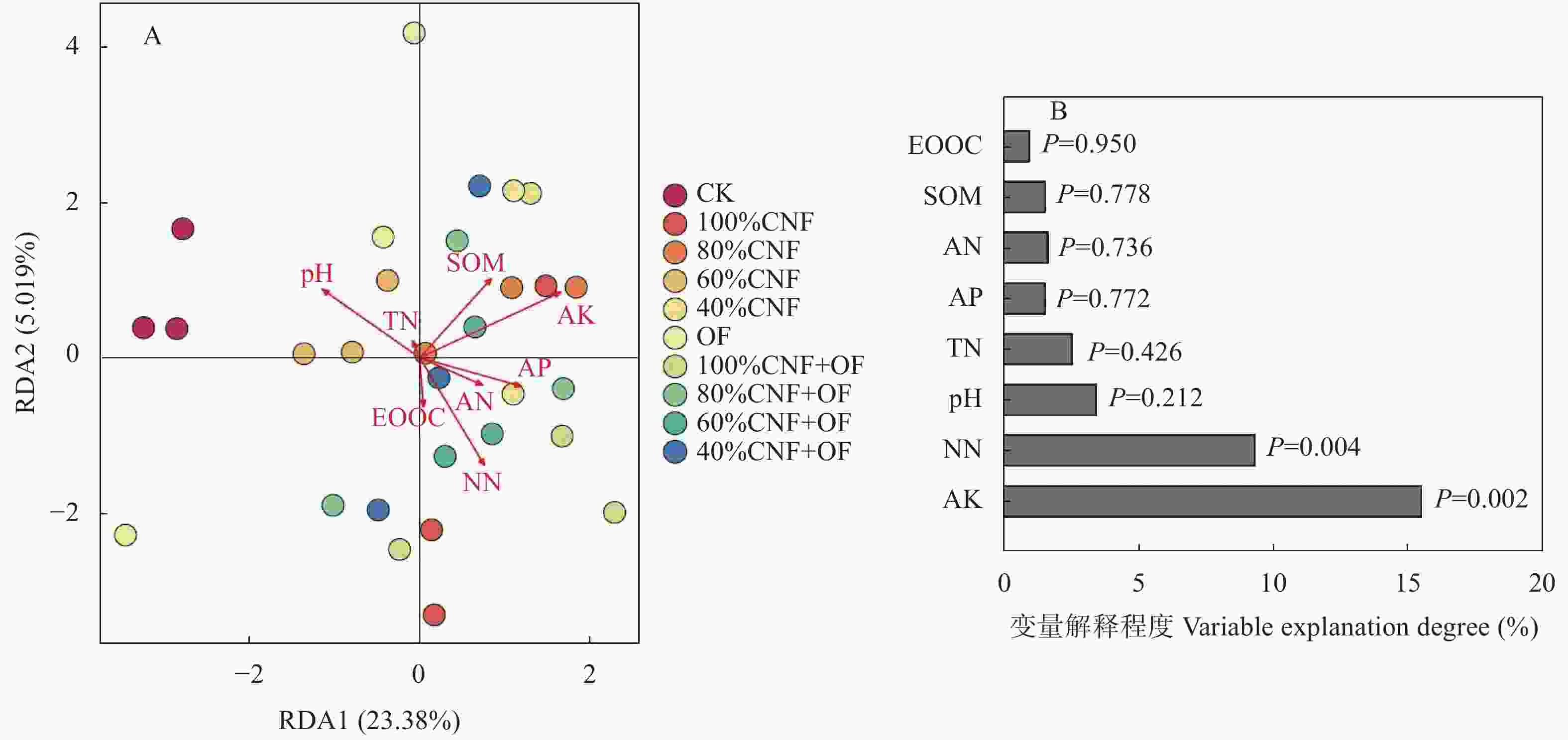Effects of reduced chemical nitrogen input combined with organic fertilizer application on the productivity of winter wheat and summer maize rotation and soil properties in central Henan Province
-
摘要: 为了探索豫中地区冬小麦-夏玉米轮作的减氮潜力, 构建适宜的作物养分管理体系, 通过连续3年的田间定位试验, 研究了化学氮肥减量配施有机肥对冬小麦-夏玉米轮作系统生产力和土壤性质的影响。田间试验设置10个处理, 包括完全不施肥(CK)、农户常规施氮量(100%CNF)、农户常规施氮量递减20% (80%CNF、60%CNF和40%CNF)、单施有机肥(OF)、农户常规施氮量配施有机肥(100%CNF+OF)及氮肥减量配施有机肥(80%CNF+OF、60%CNF+OF和40%CNF+OF)。分析各处理间小麦、玉米籽粒产量和地上部生物量以及土壤理化性质、酶活性和细菌群落的差异。结果表明, 不配施有机肥条件下, 小麦和玉米籽粒产量和地上部生物量均以80%CNF处理最高。与100%CNF相比, 80%CNF处理小麦籽粒产量和地上部生物量分别增加9.67%~10.55%和30.53%~35.76%, 玉米籽粒产量和地上部生物量分别增加28.06%~51.42%和29.62%~41.27%。有机肥施用进一步扩大氮肥减量空间, 60%CNF+OF和40%CNF+OF处理小麦产量较80%CNF处理无差异, 60%CNF+OF处理玉米产量较80%CNF处理无差异。减氮及其配施有机肥并不影响土壤有机质、易氧化有机碳和全氮含量以及pH, 但大幅降低硝态氮含量, 对铵态氮、速效磷和速效钾含量的影响因处理不同而异。与100%CNF相比, 减氮配施有机肥增加土壤脲酶和芳基硫酸酯酶活性, 但降低了β-葡萄糖苷酶活性, 对蔗糖酶、碱性磷酸酶和脱氢酶活性无显著影响。减氮配施有机肥处理能够改善土壤细菌群落α多样性, 60%CNF+OF和40%CNF+OF处理辛普森指数和均匀度指数较100%CNF均显著增加。减氮配施有机肥也显著影响土壤细菌群落β多样性, 且氮肥减量相较有机肥施用效果更为突出。在门水平, 变形菌门、放线菌门和酸杆菌门是细菌群落优势成员, 减氮配施有机肥较100%CNF处理显著降低放线菌门平均相对丰度为10.92%~14.39%; 在属水平, 减氮配施有机肥处理显著增加unclassified Gp6和Sphingomonas平均相对丰度, 但降低了Nocardioides、Kribbella、Lechevalieria、Promicromonospora、Massilia、Glycomyces和Dongia平均相对丰度。冗余分析表明, 速效钾和硝态氮含量是影响细菌群落结构最重要的2个土壤理化因子。共发生网络分析也证实, 化学氮肥减施增强了细菌群落成员的互作强度, 提高了细菌互作网络的复杂性和连通性。本试验条件下, 小麦和玉米季农户常规施氮量分别减少60%和40%并各配施3000 kg∙hm−2有机肥能够维持相对较高的轮作生产力, 这不仅能够实现最大减氮潜力, 同时还能改善土壤微生物多样性和群落结构。Abstract: To explore the potential of nitrogen (N) reduction in winter wheat and summer maize rotation system located at central Henan Province and pursue the best crop nutrient management strategy, the effects of reduced chemical N fertilization (RCN) combined with organic fertilizer application (OFA) on rotation system productivity and soil properties were assessed through a field experiment over three years. Ten treatments were employed in the present study: without fertilization (CK), farmers’ chemical N application rate (100%CNF), gradually reducing the chemical N application rate by 20% (80%CNF, 60%CNF, and 40%CNF), applying organic fertilizer alone (OF), and combined application of RCN and OFA (100%CNF+OF, 80%CNF+OF, 60%CNF+OF, and 40%CNF+OF). The differences in grain yields and aboveground biomass of wheat and maize, soil physicochemical properties, enzymes activities, and bacterial communities among treatments were analyzed. In the absence of OFA, the highest grain yield and aboveground biomass for wheat and maize were achieved with 80%CNF. Compared with 100%CNF, grain yield and aboveground biomass of wheat in 80%CNF significantly increased by 9.67%−10.55% and 30.53%−35.76%, respectively, and those of maize in 80%CNF significantly increased by 28.06%−51.42% and 29.62%−41.27%, respectively, suggesting that farmers’ conventional fertilization constituted excessive N supply. Furthermore, reducing 20% of farmers’ chemical N fertilization significantly increased rotation system productivity. The OFA could further release the space for N reduction, which was confirmed by the lack of statistical difference in wheat grain yield among 60%CNF+OF, 40%CNF+OF, and 80%CNF; and in maize grain yield between 60%CNF+OF and 80%CNF. The RCN alone or in combination with OFA did not alter the contents of soil organic matter, easily oxidized organic carbon, and total nitrogen, or pH, but substantially reduced the NO3−-N content. The effects of RCN and OFA on the contents of NH4+-N, available phosphorus, and available potassium varied among treatments. Compared to 100%CNF, RCN combined with OFA significantly increased the activities of urease and arylsulfatase and reduced the activity of β-glucosidase but did not affect the activities of sucrase, alkaline phosphatase, and dehydrogenase. The combination of RCN with OFA improved the α diversity of the bacterial community. This was indicated by the Simpson and evenness indices in 60%CNF+OF and 40%CNF+OF being significantly higher than those of 100%CNF. The RCN combined with OFA also significantly changed the β diversity of the bacterial community, which was more dependent on RCN rather than OFA. At the phylum level, Proteobacteria, Actinobacteria, and Acidobacteria dominated the bacterial community. The combinations of RCN and OFA significantly reduced the average relative abundance of Actinobacteria by 10.92%–14.39%. At the genus level, RCN combined with OFA significantly increased the average relative abundances of unclassified GP6 and Sphingomonas, whereas reduced the average relative abundances of Nocardioides, Kribbella, Lechevalieria, Promicromonospora
, Massilia, Glycomyces , and Dongia. Redundancy analysis demonstrated that available potassium and NO3−-N contents were the two most important soil environmental variables driving the bacterial community structure. In addition, co-occurrence network analysis also indicated that RCN strengthened the interactions of species in the bacterial community and yielded highly complex and connected associations among bacterial taxa. In the current study, reducing 60% and 40% of farmers’ chemical N fertilization in wheat and maize production, respectively, and in combination with 3000 kg∙hm−2 of OFA in each season could maintain relatively high rotation productivity. This fertilization regime not only maximized the potential of N reduction in the rotation system but also improved soil microbial diversity and community structure. Notably, the optimal fertilization regime obtained here must be re-verified across crop varieties, organic fertilizers, and fields. Moreover, the long-term effects of RCN and OFA on yield and soil properties in winter wheat and summer maize rotation systems in central Henan Province need to be further assessed. -
图 1 2019年玉米收获时各施肥处理下土壤细菌群落β多样性的比较
A: 所有供试处理间的土壤细菌群落β多样性比较; B: 施用有机肥与不施用有机肥处理间的土壤细菌群落β多样性比较; C: 不施用有机肥处理间的土壤细菌群落β多样性比较; D: 施用有机肥处理间的土壤细菌群落β多样性比较; E: 剔除CK后不施用有机肥处理间土壤细菌群落β多样性比较; F: 剔除OF后施用有机肥处理间土壤细菌群落β多样性比较。Comparison of the β diversity of soil bacterial community under all tested treatments (A), between the treatments with and without organic fertilization (B), among treatments without organic fertilization (C), among treatments with organic fertilization (D), among treatments without organic fertilization after removing CK (E), and among treatments with organic fertilization after removing OF (F).
Figure 1. The β diversity of soil bacterial community under different fertilization treatments at maize harvest in 2019
图 2 2019年玉米收获时土壤细菌群落中最丰富的50个属在不同施肥处理下的平均相对丰度变化
同行不同小写字母表示不同处理间差异显著(P<0.05), 括号中数字表示该细菌属在30个供试土壤样本中的平均相对丰度, 比例尺表示平均相对丰度。Within a row, different lowercase letters mean significant differences at P<0.05 level among treatments. The number in brackets indicates the mean of average relative abundance of this genus across 30 tested soil samples, and the scale represents average relative abundance.
Figure 2. Average relative abundances of top 50 abundant genera in soil bacterial community under different fertilization treatments at maize harvest in 2019
图 3 土壤理化性质与细菌群落结构的关系
SOM: 土壤有机质; TN: 全氮; EOOC: 易氧化有机碳; AN: 铵态氮; NN: 硝态氮; AP: 速效磷; AK: 速效钾。SOM: organic matter; TN: total nitrogen; EOOC: easily oxidized organic carbon; AN: NH4+-N; NN: NO3−-N; AP: available phosphorus; AK: available potassium.
Figure 3. Relationship of soil physicochemical properties and bacterial community structure
表 1 田间试验各处理施肥量
Table 1. Fertilization rates in different treatments employed in the present study
处理
Treatment小麦 Wheat 玉米 Maize 小麦+玉米(全年) Wheat + maize (annual) 化肥 Chemical fertilizer 有机肥
Organic fertilizer化肥 Chemical fertilizer 有机肥
Organic fertilizer化肥 Chemical fertilizer 有机肥
Organic fertilizerN P2O5 K2O N P2O5 K2O N P2O5 K2O kg∙hm−2 CK 0 0 0 0 0 0 0 0 0 0 0 0 100%CNF 225 120 120 0 270 120 120 0 495 240 240 0 80%CNF 180 120 120 0 216 120 120 0 396 240 240 0 60%CNF 135 120 120 0 162 120 120 0 297 240 240 0 40%CNF 90 120 120 0 108 120 120 0 198 240 240 0 OF 0 0 0 3000 0 0 0 3000 0 0 0 6000 100%CNF+OF 225 120 120 3000 270 120 120 3000 495 240 240 6000 80%CNF+OF 180 120 120 3000 216 120 120 3000 396 240 240 6000 60%CNF+OF 135 120 120 3000 162 120 120 3000 297 240 240 6000 40%CNF+OF 90 120 120 3000 108 120 120 3000 198 240 240 6000 有机肥用量基于肥料生产商推荐。The application rate of organic fertilizer is recommended by the fertilizer manufacturer. 表 2 2017—2019年各施肥处理下小麦、玉米的籽粒产量和地上部生物量
Table 2. Grain yields and aboveground biomasses of wheat and maize under different fertilization treatments from 2017 to 2019
作物
Crop处理
Treatment籽粒产量 Grain yield 地上部生物量 Aboveground biomass 2017 2018 2019 2017 2018 2019 t∙hm−2 小麦 Wheat CK 8.03±0.30e 7.14±0.77c 7.48±0.61f 22.83±2.89f 24.57±3.31e 23.98±3.43d 100%CNF 12.41±0.22bcd 12.23±0.18ab 12.23±0.71bcd 33.47±1.77e 33.57±3.65d 34.06±2.68c 80%CNF 13.61±0.68a 13.52±0.63a 13.46±0.12ab 45.44±1.22ab 44.97±0.63ab 44.46±1.44ab 60%CNF 13.38±0.32ab 12.76±0.57ab 12.74±0.17abcd 35.95±2.34de 40.49±2.05bc 37.93±1.19bc 40%CNF 11.73±0.54d 12.00±0.75b 11.80±0.14d 35.16±2.08de 36.45±2.45cd 34.00±1.94c OF 8.57±0.70e 8.14±0.70c 8.72±1.27e 24.55±2.88f 26.96±4.68e 26.52±3.85d 100%CNF+OF 12.13±1.11cd 11.95±0.33b 12.16±0.61cd 37.89±3.23cde 36.37±3.83cd 36.80±3.09c 80%CNF+OF 13.65±0.43a 13.50±1.11a 13.49±0.66a 48.74±4.45a 48.21±3.11a 46.89±5.95a 60%CNF+OF 13.10±0.70abc 13.30±0.43ab 12.71±0.42abcd 39.62±1.46cd 41.20±1.61bc 39.62±3.32bc 40%CNF+OF 13.32±0.56ab 12.75±1.11ab 13.13±0.90abc 42.72±3.12bc 41.00±1.58bc 44.30±5.52ab 玉米 Maize CK 7.44±0.76d 7.80±0.62e 7.70±1.08d 20.05±2.32d 20.42±2.39e 20.31±2.49f 100%CNF 10.25±0.42c 10.94±0.50cd 9.53±1.13cd 28.55±2.12bc 29.24±1.37cd 27.84±2.82cde 80%CNF 13.57±1.41ab 14.01±1.52a 14.43±2.91a 37.46±2.23a 37.90±1.53a 39.33±3.58a 60%CNF 12.30±1.05ab 12.26±0.75abcd 11.72±1.39bc 31.40±5.40abc 31.35±5.23bcd 30.81±5.89bcde 40%CNF 10.33±0.93c 10.61±1.43d 9.42±0.69cd 26.20±2.46c 26.48±1.87d 25.29±2.34ef OF 7.50±0.63d 7.94±0.23e 8.02±1.50d 25.84±3.45c 26.28±2.60d 26.36±4.22def 100%CNF+OF 11.85±0.12bc 11.91±1.33bcd 12.42±1.10b 31.93±3.74abc 31.99±4.32bcd 32.50±4.61abcd 80%CNF+OF 12.74±1.30ab 13.46±0.54ab 13.19±0.40ab 35.61±3.97a 36.33±2.88ab 35.39±3.71ab 60%CNF+OF 13.92±1.05a 13.65±1.24ab 13.47±1.37ab 34.77±4.25ab 34.50±4.23abc 34.31±4.44abc 40%CNF+OF 12.04±0.66b 12.58±0.76abc 12.19±0.45b 33.34±0.16ab 33.88±1.23abc 33.49±0.13abc 同列不同小写字母表示同一作物不同处理间差异显著(P<0.05)。Within a column, different lowercase letters mean significant differences at P<0.05 level among treatments for the same crop. 表 3 2019年玉米收获时各施肥处理下土壤理化性质
Table 3. Soil physicochemical properties under different fertilization treatments at maize harvest in 2019
处理
Treatment有机质Organic matter
(g∙kg−1)易氧化有机碳Easily oxidized organic carbon
(g∙kg−1)全氮Total nitrogen
(g∙kg−1)铵态氮
NH4+-N (mg∙kg−1)硝态氮
NO3−-N (mg∙kg−1)速效磷
Available phosphorus (mg∙kg−1)速效钾Available potassium
(mg∙kg−1)pH CK 26.09±0.73a 8.78±2.16a 1.44±0.15a 4.00±1.41bc 1.89±0.98c 3.50±0.99c 162.67±3.79c 7.93±0.13a 100%CNF 25.46±2.02a 8.01±1.13a 1.45±0.18a 4.05±1.58bc 19.05±7.62a 13.74±1.59ab 209.67±43.29bc 7.76±0.14a 80%CNF 28.66±1.65a 9.26±3.03a 1.35±0.16a 4.71±1.17abc 4.35±1.60bc 10.51±4.89bc 288.00±22.52a 7.89±0.11a 60%CNF 28.37±1.71a 8.77±0.61a 1.41±0.03a 2.79±0.80c 2.23±0.57c 10.51±6.75bc 197.33±23.97bc 7.90±0.05a 40%CNF 25.89±2.23a 9.43±1.99a 1.35±0.09a 4.54±0.38abc 2.63±0.71bc 10.02±3.37bc 245.33±34.08ab 7.82±0.04a OF 26.55±2.95a 8.83±3.02a 1.35±0.16a 3.38±0.76bc 1.62±0.76c 5.06±4.71c 191.33±31.47bc 7.89±0.11a 100%CNF+OF 27.34±2.47a 9.33±1.81a 1.40±0.08a 4.70±0.45abc 8.82±2.72b 13.98±2.06ab 218.33±32.72bc 7.75±0.15a 80%CNF+OF 28.20±0.51a 10.73±3.65a 1.40±0.10a 4.32±0.86abc 7.28±3.83bc 20.09±0.76a 235.67±37.31ab 7.84±0.15a 60%CNF+OF 26.71±1.68a 8.21±1.54a 1.24±0.10a 4.98±1.16ab 6.04±4.92bc 13.32±7.79ab 243.00±36.51ab 7.84±0.05a 40%CNF+OF 27.92±1.93a 9.42±0.76a 1.33±0.11a 6.25±1.41a 3.56±0.45bc 6.88±3.25bc 206.33±46.01bc 7.85±0.06a 同列不同小写字母表示不同处理间差异显著(P<0.05)。Within a column, different lowercase letters mean significant differences at P<0.05 level among treatments. 表 4 2019年玉米收获时各施肥处理下土壤酶活性的比较
Table 4. Soil enzymes activities under different fertilization treatments at maize harvest in 2019
处理
Treatment脲酶 UA[µg(NH4+-N)∙g−1∙h−1] 蔗糖酶 SU
[mg(glucose)∙g−1∙h−1]碱性磷酸酶 ALP
[µg(phenol)∙g−1∙h−1]芳基硫酸酯酶 ARL
[µg(n-nitrophenol)∙g−1∙h−1]脱氢酶 DA
[μg(TPF)∙g−1∙h−1]β-葡萄糖苷酶 GLU
[µg(glucose)∙g−1∙h−1]CK 97.27±19.63b 1.81±0.26b 0.27±0.18abc 23.37±0.91bc 2.78±0.51ab 49.16±11.97bc 100%CNF 97.66±14.38b 1.78±0.15b 0.28±0.18abc 23.03±2.24bc 2.57±0.64ab 72.05±15.62a 80%CNF 95.81±8.95b 1.79±0.11b 0.16±0.07c 21.05±1.09c 2.93±0.38ab 70.27±3.79ab 60%CNF 97.75±23.27b 1.78±0.29b 0.20±0.07c 22.48±2.62bc 3.53±0.49a 62.84±2.92ab 40%CNF 97.17±5.23b 1.91±0.18b 0.24±0.12bc 20.97±3.03c 2.03±0.27b 56.59±17.45abc OF 82.95±20.50b 1.72±0.23b 0.39±0.07abc 22.39±4.60bc 2.77±0.38ab 38.16±12.59c 100%CNF+OF 105.83±15.12ab 2.28±0.15a 0.52±0.07a 35.26±17.23ab 3.03±1.36ab 62.54±9.54ab 80%CNF+OF 109.34±10.23ab 1.94±0.13b 0.48±0.20ab 31.39±5.34abc 3.13±0.40ab 63.28±4.64ab 60%CNF+OF 107.20±18.99ab 1.88±0.12b 0.40±0.07abc 39.78±10.52a 2.76±0.59ab 40.76±9.59c 40%CNF+OF 132.90±15.48a 1.81±0.06b 0.36±0.12abc 23.76±6.12bc 2.79±0.19ab 52.73±15.32abc 同列不同小写字母表示不同处理间差异显著(P<0.05)。Within a column, different lowercase letters mean significant differences at P<0.05 level among treatments. UA: urease; SU: sucrase; ALP: alkaline phosphatase; ARL: arylsulphatase; DA: dehydrogenase; GLU: β-glucosidase. 表 5 2019年玉米收获时各施肥处理下土壤细菌群落α多样性的比较
Table 5. The α diversity of soil bacterial community under different fertilization treatments at maize harvest in 2019
处理
Treatment物种数
Observed species丰富度
Chao1 index香农指数
Shannon index辛普森指数
Simpson index均匀度指数
Pielou index谱系多样性指数
Faith indexCK 6191.7±239.4a 6957.3±297.3a 11.45±0.07a 0.9993±0.0001a 0.9807±0.0013a 430.6±28.2a 100%CNF 6247.5±82.7a 7076.3±95.4a 11.30±0.03bc 0.9990±0.0001bc 0.8960±0.0013d 433.9±11.4a 80%CNF 6418.9±386.4a 7237.3±395.4a 11.39±0.07abc 0.9991±0.0001abc 0.9003±0.0039bcd 446.6±19.6a 60%CNF 6251.4±265.9a 7038.9±375.9a 11.40±0.06abc 0.9992±0.0001a 0.9037±0.0016ab 447.2±31.2a 40%CNF 6166.2±225.5a 6984.9±182.1a 11.28±0.07c 0.9990±0.0001c 0.8962±0.0025d 434.6±22.1a OF 6423.8±131.3a 7210.5±113.7a 11.43±0.08ab 0.9992±0.0001ab 0.9036±0.0044ab 451.6±16.3a 100%CNF+OF 6559.1±363.6a 7437.4±395.3a 11.38±0.10abc 0.9991±0.0001abc 0.8975±0.0032cd 462.3±23.1a 80%CNF+OF 6369.5±335.5a 7232.4±396.0a 11.40±0.09abc 0.9992±0.0001ab 0.9019±0.0019bc 450.9±31.0a 60%CNF+OF 6414.7±178.0a 7258.7±158.9a 11.40±0.06abc 0.9992±0.0001a 0.9016±0.0025bc 447.9±17.3a 40%CNF+OF 6313.3±137.0a 7140.6±154.9a 11.42±0.04ab 0.9992±0.0001a 0.9048±0.0031ab 445.7±11.5a 同列不同小写字母表示不同处理间差异显著(P<0.05)。Within a column, different lowercase letters mean significant differences at P<0.05 level among treatments. 表 6 2019年玉米收获时各施肥处理下土壤主要细菌门平均相对丰度的比较
Table 6. Average relative abundances of soil major bacterial phyla under different fertilization treatments at maize harvest in 2019
处理
Treatment变形菌门
Proteobacteria放线菌门
Actinobacteria酸杆菌门
Acidobacteria拟杆菌门
Bacteroidetes绿弯菌门
Chloroflexi髌骨细菌门
Patescibacteria芽单胞菌门
Gemmatimonadetes疣微菌门
Verrucomicrobia% CK 30.09±0.80bc 26.80±3.25ab 14.65±2.24a 6.76±0.29b 8.11±0.33a 2.22±0.48d 3.16±0.42ab 1.88±0.70a 100%CNF 31.46±0.45abc 28.29±1.09a 11.41±1.63b 7.90±0.96ab 7.04±0.64b 3.58±0.33ab 2.90±0.48ab 1.57±0.48a 80%CNF 32.39±1.44a 26.51±1.46ab 12.54±0.91ab 8.91±0.96a 6.48±0.67b 3.19±0.38abc 3.02±0.33ab 1.71±0.19a 60%CNF 31.02±0.29abc 25.20±1.83b 13.26±1.30ab 8.03±0.56ab 7.56±0.06ab 3.07±0.46bcd 3.28±0.39ab 1.93±0.61a 40%CNF 30.97±0.34abc 29.06±1.71a 11.38±0.51b 8.72±0.39a 7.15±0.45ab 3.60±0.49ab 2.53±0.07b 1.32±0.23a OF 29.80±1.16c 29.07±1.66a 12.84±2.67ab 7.76±1.82ab 7.26±0.91ab 2.49±0.57cd 2.91±0.77ab 1.97±0.60a 100%CNF+OF 32.38±1.20a 26.99±0.89ab 11.03±1.40b 8.36±0.57ab 6.49±0.52b 3.82±0.86ab 3.06±0.29ab 2.08±0.18a 80%CNF+OF 33.05±2.28a 24.60±1.44b 12.67±0.81ab 8.54±1.15a 6.55±0.81b 3.41±0.14ab 3.21±0.17ab 1.95±0.63a 60%CNF+OF 32.03±0.92ab 24.22±0.88b 13.90±1.14ab 8.87±0.11a 6.75±0.24b 3.33±0.39abc 3.39±0.38a 1.72±0.71a 40%CNF+OF 32.31±1.18a 24.42±0.60b 12.91±0.73ab 8.48±0.97a 7.05±0.30b 4.03±0.31a 3.34±0.33a 1.73±0.49a 同列不同小写字母表示不同处理间差异显著(P<0.05)。Within a column, different lowercase letters mean significant differences at P<0.05 level among treatments. 表 7 2019年玉米收获时土壤不同减氮处理下细菌共发生网络的拓扑学性质比较
Table 7. Topological properties of bacterial co-occurrence networks under reduced N fertilization conditions at maize harvest in 2019
网络性质
Network property100%
CNF80%
CNF60%
CNF40%
CNF节点数 Number of nodes 115 116 115 114 边数 Number of edges 321 330 456 469 正相关边数 Number of positive edges 184 160 234 227 负相关边数 Number of negative edges 137 170 222 242 模块度 Modularity 0.576 0.613 0.540 0.476 模块数 Number of modules 8 8 6 7 网络直径 Network diameter 8 10 8 7 平均路径长度 Average path length 3.564 3.956 3.251 3.250 平均度 Average degree 5.583 5.690 7.930 8.228 图形密度 Graph density 0.049 0.049 0.070 0.073 平均聚类系数 Average clustering coefficient 0.272 0.279 0.304 0.360 -
[1] WEI W L, YAN Y, CAO J, et al. Effects of combined application of organic amendments and fertilizers on crop yield and soil organic matter: an integrated analysis of long-term experiments[J]. Agriculture, Ecosystems & Environment, 2016, 225: 86−92 [2] MIAO Y X, STEWART B A, ZHANG F S. Long-term experiments for sustainable nutrient management in China. A review[J]. Agronomy for Sustainable Development, 2011, 31(2): 397−414 doi: 10.1051/agro/2010034 [3] NINH H T, GRANDY A S, WICKINGS K, et al. Organic amendment effects on potato productivity and quality are related to soil microbial activity[J]. Plant and Soil, 2015, 386(1/2): 223−236 [4] LI H, FENG W T, HE X H, et al. Chemical fertilizers could be completely replaced by manure to maintain high maize yield and soil organic carbon (SOC) when SOC reaches a threshold in the Northeast China Plain[J]. Journal of Integrative Agriculture, 2017, 16(4): 937−946 doi: 10.1016/S2095-3119(16)61559-9 [5] SAHARIAH B, DAS S, GOSWAMI L, et al. An avenue for replacement of chemical fertilization under rice-rice cropping pattern: sustaining soil health and organic C pool via MSW-based vermicomposts[J]. Archives of Agronomy and Soil Science, 2020, 66(10): 1449−1465 doi: 10.1080/03650340.2019.1679782 [6] LUAN H A, GAO W, HUANG S W, et al. Partial substitution of chemical fertilizer with organic amendments affects soil organic carbon composition and stability in a greenhouse vegetable production system[J]. Soil and Tillage Research, 2019, 191: 185−196 doi: 10.1016/j.still.2019.04.009 [7] JI L F, NI K, WU Z D, et al. Effect of organic substitution rates on soil quality and fungal community composition in a tea plantation with long-term fertilization[J]. Biology and Fertility of Soils, 2020, 56(5): 633−646 doi: 10.1007/s00374-020-01439-y [8] ZHANG X Y, FANG Q C, ZHANG T, et al. Benefits and trade-offs of replacing synthetic fertilizers by animal manures in crop production in China: a meta-analysis[J]. Global Change Biology, 2020, 26(2): 888−900 doi: 10.1111/gcb.14826 [9] 申长卫, 袁敬平, 李新华, 等. 有机肥氮替代20%化肥氮提高豫北冬小麦氮肥利用率和土壤肥力[J]. 植物营养与肥料学报, 2020, 26(8): 1395−1406 doi: 10.11674/zwyf.19504SHEN C W, YUAN J P, LI X H, et al. Improving winter wheat N utilization efficiency and soil fertility through replacement of chemical N by 20% organic manure[J]. Journal of Plant Nutrition and Fertilizers, 2020, 26(8): 1395−1406 doi: 10.11674/zwyf.19504 [10] 吕凤莲, 侯苗苗, 张弘弢, 等. 土冬小麦–夏玉米轮作体系有机肥替代化肥比例研究[J]. 植物营养与肥料学报, 2018, 24(1): 22−32 doi: 10.11674/zwyf.17210LYU F L, HOU M M, ZHANG H T, et al. Replacement ratio of chemical fertilizer nitrogen with manure under the winter wheat-summer maize rotation system in Lou soil[J]. Journal of Plant Nutrition and Fertilizers, 2018, 24(1): 22−32 doi: 10.11674/zwyf.17210 [11] CHAPARRO J M, SHEFLIN A M, MANTER D K, et al. Manipulating the soil microbiome to increase soil health and plant fertility[J]. Biology and Fertility of Soils, 2012, 48(5): 489−499 doi: 10.1007/s00374-012-0691-4 [12] WAGG C, BENDER S F, WIDMER F, et al. Soil biodiversity and soil community composition determine ecosystem multifunctionality[J]. PNAS, 2014, 111(14): 5266−5270 doi: 10.1073/pnas.1320054111 [13] SALWAN R, SHARMA A, SHARMA V. Microbes mediated plant stress tolerance in saline agricultural ecosystem[J]. Plant and Soil, 2019, 442(1/2): 1−22 [14] 赵亚南, 徐霞, 黄玉芳, 等. 河南省小麦、玉米氮肥需求及节氮潜力[J]. 中国农业科学, 2018, 51(14): 2747−2757 doi: 10.3864/j.issn.0578-1752.2018.14.012ZHAO Y N, XU X, HUANG Y F, et al. Nitrogen requirement and saving potential for wheat and maize in Henan Province[J]. Scientia Agricultura Sinica, 2018, 51(14): 2747−2757 doi: 10.3864/j.issn.0578-1752.2018.14.012 [15] 赵亚南, 徐霞, 孙笑梅, 等. 基于GIS的河南省不同区域小麦氮磷钾推荐量与施肥配方[J]. 植物营养与肥料学报, 2021, 27(6): 938−948 doi: 10.11674/zwyf.20557ZHAO Y N, XU X, SUN X M, et al. GIS-based NPK recommendation and fertilizer formulae for wheat production in different regions of Henan Province[J]. Journal of Plant Nutrition and Fertilizers, 2021, 27(6): 938−948 doi: 10.11674/zwyf.20557 [16] 鲍士旦. 土壤农化分析[M]. 北京: 中国农业出版社, 2008BAO S D. Analytical Methods of Soils and Agrochemistry[M]. Beijing: China Agriculture Press, 2008 [17] ZHANG D B, YAO P W, ZHAO N, et al. Building up the soil carbon pool via the cultivation of green manure crops in the Loess Plateau of China[J]. Geoderma, 2019, 337: 425−433 doi: 10.1016/j.geoderma.2018.09.053 [18] 李振高, 骆永明, 滕应. 土壤与环境微生物研究法[M]. 北京: 科学出版社, 2008LI Z G, LUO Y M, TENG Y. Analytical Methods in Soil and Environmental Microbiology[M]. Beijing: Science Press, 2008 [19] XU N, TAN G C, WANG H Y, et al. Effect of biochar additions to soil on nitrogen leaching, microbial biomass and bacterial community structure[J]. European Journal of Soil Biology, 2016, 74: 1−8 doi: 10.1016/j.ejsobi.2016.02.004 [20] BOLYEN E, RIDEOUT J R, DILLON M R, et al. Reproducible, interactive, scalable and extensible microbiome data science using QIIME 2[J]. Nature Biotechnology, 2019, 37(8): 852−857 doi: 10.1038/s41587-019-0209-9 [21] RAMIREZ K S, CRAINE J M, FIERER N. Consistent effects of nitrogen amendments on soil microbial communities and processes across biomes[J]. Global Change Biology, 2012, 18(6): 1918−1927 doi: 10.1111/j.1365-2486.2012.02639.x [22] JANSSENS I A, DIELEMAN W, LUYSSAERT S, et al. Reduction of forest soil respiration in response to nitrogen deposition[J]. Nature Geoscience, 2010, 3(5): 315−322 doi: 10.1038/ngeo844 [23] SHEN W S, NI Y Y, GAO N, et al. Bacterial community composition is shaped by soil secondary salinization and acidification brought on by high nitrogen fertilization rates[J]. Applied Soil Ecology, 2016, 108: 76−83 doi: 10.1016/j.apsoil.2016.08.005 [24] ZENG J, LIU X J, SONG L, et al. Nitrogen fertilization directly affects soil bacterial diversity and indirectly affects bacterial community composition[J]. Soil Biology and Biochemistry, 2016, 92: 41−49 doi: 10.1016/j.soilbio.2015.09.018 [25] TANG H M, LI C, XIAO X P, et al. Effects of short-term manure nitrogen input on soil microbial community structure and diversity in a double-cropping paddy field of Southern China[J]. Scientific Reports, 2020, 10: 13540 doi: 10.1038/s41598-020-70612-y [26] XU A X, LI L L, COULTER J A, et al. Long-term nitrogen fertilization impacts on soil bacteria, grain yield and nitrogen use efficiency of wheat in semiarid Loess Plateau, China[J]. Agronomy, 2020, 10(8): 1175 doi: 10.3390/agronomy10081175 [27] ZHANG M L, ZHANG X, ZHANG L Y, et al. The stronger impact of inorganic nitrogen fertilization on soil bacterial community than organic fertilization in short-term condition[J]. Geoderma, 2021, 382: 114752 doi: 10.1016/j.geoderma.2020.114752 [28] ZHOU J, GUAN D W, ZHOU B K, et al. Influence of 34-years of fertilization on bacterial communities in an intensively cultivated black soil in northeast China[J]. Soil Biology and Biochemistry, 2015, 90: 42−51 doi: 10.1016/j.soilbio.2015.07.005 [29] VAN DER BOM F, NUNES I, RAYMOND N S, et al. Long-term fertilisation form, level and duration affect the diversity, structure and functioning of soil microbial communities in the field[J]. Soil Biology and Biochemistry, 2018, 122: 91−103 doi: 10.1016/j.soilbio.2018.04.003 [30] DAI X L, SONG D L, ZHOU W, et al. Partial substitution of chemical nitrogen with organic nitrogen improves rice yield, soil biochemical indictors and microbial composition in a double rice cropping system in South China[J]. Soil and Tillage Research, 2021, 205: 104753 doi: 10.1016/j.still.2020.104753 [31] LI J, COOPER J M, LIN Z A, et al. Soil microbial community structure and function are significantly affected by long-term organic and mineral fertilization regimes in the North China Plain[J]. Applied Soil Ecology, 2015, 96: 75−87 doi: 10.1016/j.apsoil.2015.07.001 [32] BLANCHET G, GAVAZOV K, BRAGAZZA L, et al. Responses of soil properties and crop yields to different inorganic and organic amendments in a Swiss conventional farming system[J]. Agriculture, Ecosystems & Environment, 2016, 230: 116−126 [33] DAI Z M, SU W Q, CHEN H H, et al. Long-term nitrogen fertilization decreases bacterial diversity and favors the growth of Actinobacteria and Proteobacteria in agro-ecosystems across the globe[J]. Global Change Biology, 2018, 24(8): 3452−3461 doi: 10.1111/gcb.14163 [34] FU L, XIONG W, DINI-ANDREOTE F, et al. Changes in bulk soil affect the disease-suppressive rhizosphere microbiome against Fusarium wilt disease[J]. Frontiers of Agricultural Science and Engineering, 2020, 7(3): 307 doi: 10.15302/J-FASE-2020328 [35] LAZCANO C, BOYD E, HOLMES G, et al. The rhizosphere microbiome plays a role in the resistance to soil-borne pathogens and nutrient uptake of strawberry cultivars under field conditions[J]. Scientific Reports, 2021, 11(1): 1−17 doi: 10.1038/s41598-020-79139-8 [36] CHEN L, REDMILE-GORDON M, LI J W, et al. Linking cropland ecosystem services to microbiome taxonomic composition and functional composition in a sandy loam soil with 28-year organic and inorganic fertilizer regimes[J]. Applied Soil Ecology, 2019, 139: 1−9 doi: 10.1016/j.apsoil.2019.03.011 [37] BUYER J S, TEASDALE J R, ROBERTS D P, et al. Factors affecting soil microbial community structure in tomato cropping systems[J]. Soil Biology and Biochemistry, 2010, 42(5): 831−841 doi: 10.1016/j.soilbio.2010.01.020 [38] PENG C J, LAI S S, LUO X S, et al. Effects of long term rice straw application on the microbial communities of rapeseed rhizosphere in a paddy-upland rotation system[J]. Science of the Total Environment, 2016, 557/558: 231−239 doi: 10.1016/j.scitotenv.2016.02.184 [39] DING J L, JIANG X, MA M C, et al. Effect of 35 years inorganic fertilizer and manure amendment on structure of bacterial and archaeal communities in black soil of northeast China[J]. Applied Soil Ecology, 2016, 105: 187−195 doi: 10.1016/j.apsoil.2016.04.010 [40] ZHU J, PENG H, JI X H, et al. Effects of reduced inorganic fertilization and rice straw recovery on soil enzyme activities and bacterial community in double-rice paddy soils[J]. European Journal of Soil Biology, 2019, 94: 103116 doi: 10.1016/j.ejsobi.2019.103116 [41] LIU W B, LING N, GUO J J, et al. Legacy effects of 8-year nitrogen inputs on bacterial assemblage in wheat rhizosphere[J]. Biology and Fertility of Soils, 2020, 56(5): 583−596 doi: 10.1007/s00374-020-01435-2 [42] YAO M J, RUI J P, LI J B, et al. Rate-specific responses of prokaryotic diversity and structure to nitrogen deposition in the Leymus chinensis steppe[J]. Soil Biology and Biochemistry, 2014, 79: 81−90 doi: 10.1016/j.soilbio.2014.09.009 [43] JIANG Y L, LEI Y B, YANG Y, et al. Divergent assemblage patterns and driving forces for bacterial and fungal communities along a glacier forefield chronosequence[J]. Soil Biology and Biochemistry, 2018, 118: 207−216 doi: 10.1016/j.soilbio.2017.12.019 [44] MORRIËN E, HANNULA S E, SNOEK L B, et al. Soil networks become more connected and take up more carbon as nature restoration progresses[J]. Nature Communications, 2017, 8: 14349 doi: 10.1038/ncomms14349 [45] MOUGI A, KONDOH M. Diversity of interaction types and ecological community stability[J]. Science, 2012, 337(6092): 349−351 doi: 10.1126/science.1220529 [46] MENDES L W, RAAIJMAKERS J M, DE HOLLANDER M, et al. Influence of resistance breeding in common bean on rhizosphere microbiome composition and function[J]. The ISME Journal, 2018, 12(1): 212−224 doi: 10.1038/ismej.2017.158 -






 下载:
下载:





